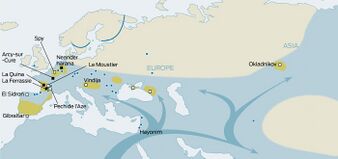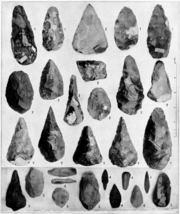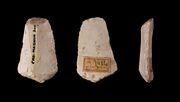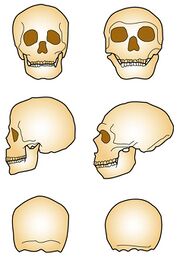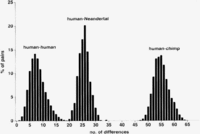Biology:Neanderthal extinction
Neanderthals became extinct around 40,000 years ago. Hypotheses on the causes of the extinction include violence, transmission of diseases from modern humans which Neanderthals had no immunity to, competitive replacement, extinction by interbreeding with early modern human populations, natural catastrophes, climate change and inbreeding depression. It is likely that multiple factors caused the demise of an already low population.
Possible coexistence before extinction
In research published in Nature in 2014, an analysis of radiocarbon dates from forty Neanderthal sites from Spain to Russia found that the Neanderthals disappeared in Europe between 41,000 and 39,000 years ago with 95% probability. The study also found with the same probability that modern humans and Neanderthals overlapped in Europe for between 2,600 and 5,400 years.[1] Modern humans reached Europe between 45,000 and 43,000 years ago.[2] Improved radiocarbon dating published in 2015 indicates that Neanderthals disappeared around 40,000 years ago, which overturns older carbon dating which indicated that Neanderthals may have lived as recently as 24,000 years ago,[3] including in refugia on the south coast of the Iberian peninsula such as Gorham's Cave.[4] Zilhão et al. (2017) argue for pushing this date forward by some 3,000 years, to 37,000 years ago.[5] Inter-stratification of Neanderthal and modern human remains has been suggested,[6] but is disputed.[7] Stone tools that have been proposed to be linked to Neanderthals have been found at Byzovya (:ru:Бызовая) in the polar Urals, and dated to 31,000 to 34,000 years ago,[8] but is also disputed.[9]
Possible cause of extinction
Violence
Kwang Hyun Ho discusses the possibility that Neanderthal extinction was either precipitated or hastened by violent conflict with Homo sapiens. Violence in early hunter-gatherer societies usually occurred as a result of resource competition following natural disasters. It is therefore plausible to suggest that violence, including primitive warfare, would have transpired between the two human species.[10] The hypothesis that early humans violently replaced Neanderthals was first proposed by French paleontologist Marcellin Boule (the first person to publish an analysis of a Neanderthal) in 1912.[11]
Parasites and pathogens
Infectious diseases carried by Homo sapiens may have passed to Neanderthals, who would have had poor protection to infections they had not previously been exposed to, leading to devastating consequences for Neanderthal populations. Homo sapiens were less vulnerable to Neanderthal diseases, partly because they had evolved to cope with the far higher disease load of the tropics and so were more able to cope with novel pathogens, and partly because the higher numbers of Homo sapiens meant that even devastating outbreaks would still have left enough survivors for a viable population.[12] If viruses could easily jump between these two similar species, possibly because they lived near together, Homo sapiens might have infected Neanderthals and prevented the epidemic from burning out as Neanderthal numbers declined. The same process may also explain Homo sapiens' resilience to Neanderthal diseases and parasites. Novel human diseases likely moved from Africa into Eurasia. This purported "African advantage" remained until the agricultural revolution 10,000 years ago in Eurasia, after which domesticated animals surpassed other primates as the most prevalent source of new human infections, replacing the "African advantage" with a "Eurasian advantage". The catastrophic impact of Eurasian viruses on Native American populations in the historical past offers a sense of how modern humans may have affected hominin predecessor groups in Eurasia 40,000 years ago. Human and Neanderthal genomes and disease or parasite adaptations may give insight on this.[13][14]
Infectious illness interactions may express the prolonged period of stagnation before the modification, as per disease ecology. Mathematical models have been used to make forecasts for future investigations, giving information about inter-species interactions during the shift between the Middle and Upper Paleolithic eras. This can be useful given the sparse material record from this time and the potential of DNA sequencing and dating technology. Such modeling, together with modern technology and prehistoric archaeological methodologies, may provide a fresh understanding of this time in human origins.[14]
Competitive replacement
Species specific disadvantages
Slight competitive advantage on the part of modern humans may have accounted for Neanderthals' decline on a timescale of thousands of years.[15][16]
Generally small and widely dispersed fossil sites suggest that Neanderthals lived in less numerous and socially more isolated groups than contemporary Homo sapiens. Tools such as Mousterian flint stone flakes and Levallois points are remarkably sophisticated from the outset, yet they have a slow rate of variability and general technological inertia is noticeable during the entire fossil period. Artifacts are of utilitarian nature, and symbolic behavioral traits are undocumented before the arrival of modern humans in Europe around 40,000 to 35,000 years ago.[15][17][18]
The noticeable morphological differences in skull shape between the two human species also have cognitive implications. These include the Neanderthals' smaller parietal lobes[19][20][21] and cerebellum,[22][23] areas implicated in tool use,[24] visuospatial integration,[25] numeracy,[26] creativity,[27] and higher-order conceptualization.[28] The differences, while slight, would have possibly been enough to affect natural selection and may underlie and explain the differences in social behaviors, technological innovation, and artistic output.[15]
Jared Diamond, a supporter of competitive replacement, points out in his book The Third Chimpanzee that the replacement of Neanderthals by modern humans is comparable to patterns of behavior that occur whenever people with advanced technology clash with people with less developed technology.[29]
Division of labor
In 2006, two anthropologists of the University of Arizona proposed an efficiency explanation for the demise of the Neanderthals.[30] In an article titled "What's a Mother to Do? The Division of Labor among Neanderthals and Modern Humans in Eurasia",[31] it was posited that Neanderthal division of labor between the sexes was less developed than Middle paleolithic Homo sapiens. Both male and female Neanderthals participated in the single occupation of hunting big game, such as bison, deer, gazelles, and wild horses. This hypothesis proposes that the Neanderthal's relative lack of labor division resulted in less efficient extraction of resources from the environment as compared to Homo sapiens.
Anatomical differences and running ability
Researchers such as Karen L. Steudel of the University of Wisconsin have highlighted the relationship of Neanderthal anatomy (shorter and stockier than that of modern humans) and the ability to run and the requirement of energy (30% more).[32]
Nevertheless, in the recent study, researchers Martin Hora and Vladimir Sladek of Charles University in Prague show that Neanderthal lower limb configuration, particularly the combination of robust knees, long heels, and short lower limbs, increased the effective mechanical advantage of the Neanderthal knee and ankle extensors, thus reducing the force needed and the energy spent for locomotion significantly. The walking cost of the Neanderthal male is now estimated to be 8–12% higher than that of anatomically modern males, whereas the walking cost of the Neanderthal female is considered to be virtually equal to that of anatomically modern females.[33]
Other researchers, like Yoel Rak, from Tel-Aviv University in Israel, have noted that the fossil records show that Neanderthal pelvises in comparison to modern human pelvises would have made it much harder for Neanderthals to absorb shocks and to bounce off from one step to the next, giving modern humans another advantage over Neanderthals in running and walking ability. However, Rak also notes that all archaic humans had wide pelvises, indicating that this is the ancestral morphology and that modern humans underwent a shift towards narrower pelvises in the late Pleistocene.[34]
Modern humans and alliance with dogs
Pat Shipman argues that the domestication of the dog gave modern humans an advantage when hunting.[35] Evidence shows the oldest remains of domesticated dogs were found in Belgium (31,700 BP) and in Siberia (33,000 BP).[36][37] A survey of early sites of modern humans and Neanderthals with faunal remains across Spain , Portugal and France provided an overview of what modern humans and Neanderthals ate.[38] Rabbit became more frequent, while large mammals – mainly eaten by the Neanderthals – became increasingly rare. In 2013, DNA testing on the "Altai dog", a paleolithic dog's remains from the Razboinichya Cave (Altai Mountains), has linked this 33,000-year-old dog with the present lineage of Canis familiaris.[39]
Interbreeding
The most vocal proponent of the hybridization hypothesis is Erik Trinkaus of Washington University in St. Louis.[40][41] Trinkaus claims various fossils as hybrid individuals, including the "child of Lagar Velho", a skeleton found at Lagar Velho in Portugal.[42] In a 2006 publication co-authored by Trinkaus, the fossils found in 1952 in the cave of Peștera Muierilor, Romania, are likewise claimed as hybrids.[43]
Genetic studies indicate some form of hybridization between archaic humans and modern humans had taken place after modern humans emerged from Africa. An estimated 1–4% of the DNA in Europeans and Asians (e.g. French, Chinese and Papua probands) is non-modern, and shared with ancient Neanderthal DNA rather than with sub-Saharan Africans (e.g. Yoruba and San probands).[44] Interbreeding took place in western Asia between about 65,000 and 47,000 years ago.[45]
Modern-human findings in Abrigo do Lagar Velho, Portugal allegedly featuring Neanderthal admixtures have been published.[46] However, the interpretation of the Portuguese specimen is disputed.[47]
Jordan, in his work Neanderthal, points out that without some interbreeding, certain features on some "modern" skulls of Eastern European Cro-Magnon heritage are hard to explain. In another study, researchers have recently found in Peştera Muierilor, Romania, remains of European humans from ~37,000–42,000 years ago[48] who possessed mostly diagnostic "modern" anatomical features, but also had distinct Neanderthal features not present in ancestral modern humans in Africa, including a large bulge at the back of the skull, a more prominent projection around the elbow joint, and a narrow socket at the shoulder joint.
The Neanderthal genome project published papers in 2010 and 2014 stating that Neanderthals contributed to the DNA of modern humans, including most humans outside sub-Saharan Africa, as well as a few populations in sub-Saharan Africa, through interbreeding, likely between 50,000 and 60,000 years ago.[49][50][51] Recent studies also show that a few Neanderthals began mating with ancestors of modern humans long before the large "out of Africa migration" of the present day non-Africans, as early as 100,000 years ago.[52] In 2016, research indicated that there were three distinct episodes of interbreeding between modern humans and Neanderthals: the first encounter involved the ancestors of non-African modern humans, probably soon after leaving Africa; the second, after the ancestral Melanesian group had branched off (and subsequently had a unique episode of interbreeding with Denisovans); and the third, involving the ancestors of East Asians only.[53]
While interbreeding is viewed as the most parsimonious interpretation of the genetic discoveries, the authors point out they cannot conclusively rule out an alternative scenario, in which the source population of non-African modern humans was already more closely related to Neanderthals than other Africans were, due to ancient genetic divisions within Africa. Among the genes shown to differ between present-day humans and Neanderthals were RPTN, SPAG17, CAN15, TTF1 and PCD16.
New evidence was discovered at Grotte Mandrin in Malataverne, France, dating back by 10,000 years. Six of the individuals were recognized as Neanderthal, but a modern human upper molar was recovered in between Neanderthal sections. At Grotte Mandrin, the existence of a modern human molar inside the Neronian layer prompted researchers to connect this stone tool manufacturing to Homo sapiens. The existence of the Homo sapiens molar beside the Neronian solidifies the narrative: Neanderthals and modern humans replaced each other multiple times in the same area. Finds at Grotte Mandrin imply the Mediterranean region had a crucial importance in shaping humans' spread into Western Eurasia. [54]
Recent research in northern Spain suggests that Neanderthals vanished earlier in Vasco-Cantabrian eastern and southern Iberia. The projected outcome will assist in assessing the consequences for regional systems of resource extraction, subsistence techniques, and environment-human connections in the Neanderthals' death and modern humans' evolutionary progress.[55]
Recent genetic evidence has revealed kinship patterns among recovered Neanderthal remains that suggests inbreeding practices [56] such as pairings between half-siblings and/or uncle/aunt and niece/nephew.[57] Researchers hypothesize that Neanderthals may have become isolated into small groups during harsh climatic conditions which contributed to inbreeding behaviours.[58] Due to the lack of genetic diversity, Neanderthal populations would have become more vulnerable to climatic changes, diseases and other stressors which may have contributed to their extinction.[59][60] A similar model to the inbreeding hypothesis can be seen among endangered lowland gorillas. Their populations are so small that it has caused inbreeding, making them even more vulnerable to extinction.[61][62]
Climate change
Neanderthals went through a demographic crisis in Western Europe that seems to coincide with climate change that resulted in a period of extreme cold in Western Europe. "The fact that Neanderthals in Western Europe were nearly extinct, but then recovered long before they came into contact with modern humans came as a complete surprise to us," said Love Dalén, associate professor at the Swedish Museum of Natural History in Stockholm. If so, this would indicate that Neanderthals may have been very sensitive to climate change.[63]
The data reveal that sudden climatic change, although crucial locally, had a limited effect on the worldwide Neanderthal population. Interbreeding and assimilation, which were hypothesized as causes in the death of European Neanderthal populations, are successful only for low levels of food competition. Future research will examine models of interbreeding, and hybridization may be evaluated using genomic records from the last ice age (Fu et al., 2016).[64]
Natural catastrophe
A number of researchers have argued that the Campanian Ignimbrite Eruption, a volcanic eruption near Naples, Italy, about 39,280 ± 110 years ago (older estimate ~37,000 years), erupting about 200 km3 (48 cu mi) of magma (500 km3 (120 cu mi) bulk volume) contributed to the extinction of Neanderthals.[65] The argument has been developed by Golovanova et al.[66][67] The hypothesis posits that although Neanderthals had encountered several Interglacials during 250,000 years in Europe,[68] inability to adapt their hunting methods caused their extinction facing H. sapiens competition when Europe changed into a sparsely vegetated steppe and semi-desert during the last Ice Age.[69] Studies of sediment layers at Mezmaiskaya Cave suggest a severe reduction of plant pollen.[67] The damage to plant life would have led to a corresponding decline in plant-eating mammals hunted by the Neanderthals.[67][70][71]
See also
- List of hominina (hominid) fossils – None
- Earth:Quaternary extinction event – Extinction event occurring during the late Quaternary period
References
- ↑ Higham, Tom (21 August 2014). "The timing and spatiotemporal patterning of Neanderthal disappearance". Nature 512 (7514): 306–309. doi:10.1038/nature13621. PMID 25143113. Bibcode: 2014Natur.512..306H.
- ↑ John Noble Wilford (2011-11-02). "Fossil Teeth Put Humans in Europe Earlier Than Thought". The New York Times. https://www.nytimes.com/2011/11/03/science/fossil-teeth-put-humans-in-europe-earlier-than-thought.html?scp=1&sq=kents%20cavern&st=cse&_r=0.
- ↑ Dorey, Fran (30 October 2015). "Homo Neanderthalensis – The Neanderthals". Australian Museum. https://australianmuseum.net.au/homo-neanderthalensis.
- ↑ Rincon, Paul (13 September 2006). "Neanderthals' 'last rock refuge'". BBC News. http://news.bbc.co.uk/1/hi/5343266.stm?lsm. "Late survival of Neanderthals at the southernmost extreme of Europe". Nature 443 (7113): 850–853. October 2006. doi:10.1038/nature05195. PMID 16971951. Bibcode: 2006Natur.443..850F.
- ↑ Zilhão, João (2017). "Precise dating of the Middle-to-Upper Paleolithic transition in Murcia (Spain) supports late Neandertal persistence in Iberia". Heliyon 3 (11): e00435. doi:10.1016/j.heliyon.2017.e00435. PMID 29188235.
- ↑ "Radiocarbon dating of interstratified Neanderthal and early modern human occupations at the Chatelperronian type-site". Nature 438 (7064): 51–56. November 2005. doi:10.1038/nature04006. PMID 16136079. Bibcode: 2005Natur.438...51G.
- ↑ Zilhão, João; Francesco d’Errico; Jean-Guillaume Bordes; Arnaud Lenoble; Jean-Pierre Texier; Jean-Philippe Rigaud (2006). "Analysis of Aurignacian interstratification at the Châtelperronian-type site and implications for the behavioral modernity of Neandertals". PNAS 103 (33): 12643–12648. doi:10.1073/pnas.0605128103. PMID 16894152. Bibcode: 2006PNAS..10312643Z.
- ↑ Slimak, L.; Svendsen, J. I.; Mangerud, J.; Plisson, H.; Heggen, H. P.; Brugere, A.; Pavlov, P. Y. (2011). "Late Mousterian Persistence near the Arctic Circle". Science 332 (6031): 841–845. doi:10.1126/science.1203866. PMID 21566192. Bibcode: 2011Sci...332..841S.
- ↑ Zwyns, Nicolas; Roebroeks, Wil; McPherron, Shannon P.; Jagich, Adam; Hublin, Jean-Jacques (2012-01-13). "Comment on "Late Mousterian Persistence near the Arctic Circle"" (in en). Science 335 (6065): 167. doi:10.1126/science.1209908. ISSN 0036-8075.
- ↑ Ko, Kwang Hyun (2016). "Hominin interbreeding and the evolution of human variation". Journal of Biological Research-Thessaloniki 23: 17. doi:10.1186/s40709-016-0054-7. PMID 27429943.
- ↑ Boule, M 1920, Les hommes fossiles, Masson, Paris.
- ↑ Kennedy, Jonathan (2023). Pathogenesis: how Germs Made History. London, UK: Torva. pp. 42–43.
- ↑ Houldcroft, Charlotte J.; Underdown, Simon J. (July 2016). "Neanderthal genomics suggests a pleistocene time frame for the first epidemiologic transition: Neanderthal Infectious Diseases Genetics" (in en). American Journal of Physical Anthropology 160 (3): 379–388. doi:10.1002/ajpa.22985. PMID 27063929. https://onlinelibrary.wiley.com/doi/10.1002/ajpa.22985.
- ↑ 14.0 14.1 Greenbaum, Gili; Getz, Wayne M.; Rosenberg, Noah A.; Feldman, Marcus W.; Hovers, Erella; Kolodny, Oren (2019-11-01). "Disease transmission and introgression can explain the long-lasting contact zone of modern humans and Neanderthals" (in en). Nature Communications 10 (1): 5003. doi:10.1038/s41467-019-12862-7. ISSN 2041-1723. PMID 31676766. Bibcode: 2019NatCo..10.5003G.
- ↑ 15.0 15.1 15.2 Wynn, Thomas; Overmann, Karenleigh A; Coolidge, Frederick L (2016). "The false dichotomy: A refutation of the Neandertal indistinguishability claim". Journal of Anthropological Sciences 94 (94): 201–221. doi:10.4436/jass.94022. PMID 26708102.
- ↑ Banks, William E.; d'Errico, Francesco; Peterson, A. Townsend; Kageyama, Masa; Sima, Adriana; Sánchez-Goñi, Maria-Fernanda (24 December 2008). Harpending, Henry. ed. "Neanderthal Extinction by Competitive Exclusion". PLOS ONE 3 (12): e3972. doi:10.1371/journal.pone.0003972. ISSN 1932-6203. PMID 19107186. Bibcode: 2008PLoSO...3.3972B.
- ↑ "Homo neanderthalensis Brief Summary". EOL. http://eol.org/pages/4454114/details.
- ↑ Peresani, M; Dallatorre, S; Astuti, P; Dal Colle, M; Ziggiotti, S; Peretto, C (2014). "Symbolic or utilitarian? Juggling interpretations of Neanderthal behavior: new inferences from the study of engraved stone surfaces". J Anthropol Sci 92 (92): 233–55. doi:10.4436/JASS.92007. PMID 25020018.
- ↑ Bruner, Emiliano (2004). "Geometric Morphometrics and Paleoneurology: Brain Shape Evolution in the Genus Homo". Journal of Human Evolution 47 (5): 279–303. doi:10.1016/j.jhevol.2004.03.009. PMID 15530349.
- ↑ Bruner, Emiliano (2010). "Morphological Differences in the Parietal Lobes with the Human Genus: A Neurofunctional Perspective". Current Anthropology 51 (1): S77–S88. doi:10.1086/650729.
- ↑ Bruner, Emiliano; Manzi, Giorgio; Arsuaga, Juan Luis (2003). "Encephalization and Allometric Trajectories in the Genus Homo: Evidence from the Neandertal and Modern Lineages". Proceedings of the National Academy of Sciences of the United States of America 100 (26): 15335–15340. doi:10.1073/pnas.2536671100. PMID 14673084. Bibcode: 2003PNAS..10015335B.
- ↑ Hublin, Jean-Jacques; Neubauer, Simon; Gunz, Philipp (2015). "Brain Ontogeny and Life History in Pleistocene Hominins". Philosophical Transactions of the Royal Society of London. Series B, Biological Sciences 370 (1663): 1–11. doi:10.1098/rstb.2014.0062. PMID 25602066.
- ↑ Weaver, Anne (2005). "Reciprocal Evolution of the Cerebellum and Neocortex in Fossil Humans". Proceedings of the National Academy of Sciences of the United States of America 102 (10): 3576–3580. doi:10.1073/pnas.0500692102. PMID 15731345. Bibcode: 2005PNAS..102.3576W.
- ↑ Orban, Guy A; Caruana, Fausto (2014). "The Neural Basis of Human Tool Use". Frontiers in Psychology 5: 310. doi:10.3389/fpsyg.2014.00310. PMID 24782809.
- ↑ Bruner, Emiliano; Iriki, Atsushi (2016). "Extending Mind, Visuospatial Integration, and the Evolution of the Parietal Lobes in the Human Genus". Quaternary International 405: 98–110. doi:10.1016/j.quaint.2015.05.019. Bibcode: 2016QuInt.405...98B.
- ↑ Piazza, Manuela; Izard, Véronique (2009). "How Humans Count: Numerosity and the Parietal Cortex". Neuroscientist 15 (3): 261–273. doi:10.1177/1073858409333073. PMID 19436075.
- ↑ Vandervert, Larry R; Schimpf, Paul H; Liu, Hesheng (2007). "How Working Memory and the Cerebellum Collaborate to Produce Creativity and Innovation". Creativity Research Journal 19 (1): 1–18. doi:10.1080/10400410709336873.
- ↑ Balsters, Joshua H; Whelan, Christopher D; Robertson, Ian H; Ramnani, Narender (2013). "Cerebellum and Cognition: Evidence for the Encoding of Higher Order Rules". Cerebral Cortex 23 (6): 1433–1443. doi:10.1093/cercor/bhs127. PMID 22617850.
- ↑ Diamond, J. (1992). The Third Chimpanzee: The Evolution and Future of the Human Animal. New York: Harper Collins, p. 45.
- ↑ Nicholas Wade, "Neanderthal Women Joined Men in the Hunt", from The New York Times , 5 December 2006
- ↑ Kuhn, Steven L.; Stiner, Mary C. (2006). "What's a Mother to Do? The Division of Labor among Neandertals and Modern Humans in Eurasia". Current Anthropology 47 (6): 953–981. doi:10.1086/507197.
- ↑ Steudel-Numbers, Karen L; Tilkens, Michael J (2004). "The Effect of Lower Limb Length on the Energetic Cost of Locomotion: Implications for Fossil Hominins". Journal of Human Evolution 47 (1): 95–109. doi:10.1016/j.jhevol.2004.06.002. PMID 15288526.
- ↑ Hora, M; Sládek, V (2014). "Influence of lower limb configuration on walking cost in Late Pleistocene humans". Journal of Human Evolution 67: 19–32. doi:10.1016/j.jhevol.2013.09.011. PMID 24485350.
- ↑ Lewin, Roger (27 April 1991). "Science: Neanderthals puzzle the anthropologists". New Scientist. https://www.newscientist.com/article/mg13017664.500-science-neanderthals-puzzle-the-anthropologists-.html.
- ↑ Shipman, P (2012). "Dog domestication may have helped humans thrive while Neandertals declined". American Scientist 100 (3): 198. doi:10.1511/2012.96.198. http://www.americanscientist.org/issues/pub/do-the-eyes-have-it/1.
- ↑ Ovodov, NDExpression error: Unrecognized word "etal". (2011). "A 33,000-Year-Old Incipient Dog from the Altai Mountains of Siberia: Evidence of the Earliest Domestication Disrupted by the Last Glacial Maximum". PLOS ONE 6 (7): e22821. doi:10.1371/journal.pone.0022821. PMID 21829526. Bibcode: 2011PLoSO...622821O.
- ↑ Germonpré, M.; Sablin, M.V.; Stevens, R.E.; Hedges, R.E.M.; Hofreiter, M.; Stiller, M.; Jaenicke-Desprese, V. (2009). "Fossil dogs and wolves from Palaeolithic sites in Belgium, the Ukraine and Russia: osteometry, ancient DNA and stable isotopes". Journal of Archaeological Science 36 (2): 473–490. doi:10.1016/j.jas.2008.09.033.
- ↑ Fa, John E.; Stewart, John R.; Lloveras, Lluís; Vargas, J. Mario (2013). "Rabbits and hominin survival in Iberia". Journal of Human Evolution 64 (4): 233–241. doi:10.1016/j.jhevol.2013.01.002. PMID 23422239.
- ↑ Druzhkova, ASExpression error: Unrecognized word "etal". (2013). "Ancient DNA Analysis Affirms the Canid from Altai as a Primitive Dog". PLOS ONE 8 (3): e57754. doi:10.1371/journal.pone.0057754. PMID 23483925. Bibcode: 2013PLoSO...857754D.
- ↑ Jones, Dan (2007). "The Neanderthal within". New Scientist 193 (2593): 28–32. doi:10.1016/s0262-4079(07)60550-8.
- ↑ Modern Humans, Neanderthals May Have Interbred; Humans and Neanderthals interbred
- ↑ "The Lagar Velho 1 Skeleton". TalkOrigins. 2000. http://www.talkorigins.org/faqs/homs/lagarvelho.html.; Sample, Ian (14 September 2006). "Life on the edge: was a Gibraltar cave last outpost of the lost neanderthal?". The Guardian. https://www.theguardian.com/science/story/0,,1871842,00.html.; "Not a lasting last for the Neandertals". John Hawks Weblog. September 2006. http://johnhawks.net/weblog/reviews/neandertals/gorhams_28000_date_2006.html.
- ↑ "Early modern humans from the Pestera Muierii, Baia de Fier, Romania". Proc. Natl. Acad. Sci. U.S.A. 103 (46): 17196–17201. November 2006. doi:10.1073/pnas.0608443103. PMID 17085588. Bibcode: 2006PNAS..10317196S.
- ↑ "A draft sequence of the Neandertal genome". Science 328 (5979): 710–722. May 2010. doi:10.1126/science.1188021. PMID 20448178. Bibcode: 2010Sci...328..710G.
- ↑ Kuhlwilm, M. et al. (2016). "Ancient gene flow from early modern humans into Eastern Neanderthals". Nature 530 (7591): 429–433. doi:10.1038/nature16544. PMID 26886800. Bibcode: 2016Natur.530..429K.
- ↑ "The early Upper Paleolithic human skeleton from the Abrigo do Lagar Velho (Portugal) and modern-human emergence in Iberia". Proceedings of the National Academy of Sciences 96 (13): 7604–7609. June 1999. doi:10.1073/pnas.96.13.7604. PMID 10377462. Bibcode: 1999PNAS...96.7604D.
- ↑ "Enzymatic determination of urea in serum based on pH measurement with the flow injection method". Analytical Chemistry 51 (2): 199–203. February 1979. doi:10.1021/ac50038a011. PMID 33580.
- ↑ Fu, Qiaomei; Hajdinjak, Mateja; Moldovan, Oana Teodora; Constantin, Silviu; Mallick, Swapan; Skoglund, Pontus; Patterson, Nick; Rohland, Nadin et al. (2015). "An early modern human from Romania with a recent Neanderthal ancestor". Nature 524 (7564): 216–219. doi:10.1038/nature14558. PMID 26098372. Bibcode: 2015Natur.524..216F.
- ↑ Sánchez-Quinto, F; Botigué, LR; Civit, S; Arenas, C; Avila-Arcos, MC; Bustamante, CD; Comas, D; Lalueza-Fox, C (October 17, 2012). "North African Populations Carry the Signature of Admixture with Neandertals". PLOS ONE 7 (10): e47765. doi:10.1371/journal.pone.0047765. PMID 23082212. Bibcode: 2012PLoSO...747765S.
- ↑ Fu, Q; Li, H; Moorjani, P; Jay, F; Slepchenko, S. M.; Bondarev, A. A.; Johnson, P. L.; Aximu-Petri, A et al. (23 October 2014). "Genome sequence of a 45,000-year-old modern human from western Siberia". Nature 514 (7523): 445–449. doi:10.1038/nature13810. PMID 25341783. Bibcode: 2014Natur.514..445F.
- ↑ Brahic, Catherine. "Humanity's forgotten return to Africa revealed in DNA", The New Scientist (February 3, 2014).
- ↑ "Neanderthals mated with modern humans much earlier than previously thought, study finds: First genetic evidence of modern human DNA in a Neanderthal individual". 17 February 2016. https://www.sciencedaily.com/releases/2016/02/160217140302.htm.
- ↑ Sankararaman (2016). "The Combined Landscape of Denisovan and Neanderthal Ancestry in Present-Day Humans". Current Biology 26 (9): 1241–1247. doi:10.1016/j.cub.2016.03.037. PMID 27032491.
- ↑ Slimak, Ludovic; Zanolli, Clément; Higham, Tom; Frouin, Marine; Schwenninger, Jean-Luc; Arnold, Lee J.; Demuro, Martina; Douka, Katerina et al. (2022-02-11). "Modern human incursion into Neanderthal territories 54,000 years ago at Mandrin, France" (in en). Science Advances 8 (6): eabj9496. doi:10.1126/sciadv.abj9496. ISSN 2375-2548. PMID 35138885.
- ↑ MarÍN-Arroyo, Ana B.; Sanz-Royo, Alicia (February 2022). "What Neanderthals and AMH ate: reassessment of the subsistence across the Middle–Upper Palaeolithic transition in the Vasco-Cantabrian region of SW Europe" (in en). Journal of Quaternary Science 37 (2): 320–334. doi:10.1002/jqs.3291. ISSN 0267-8179. https://onlinelibrary.wiley.com/doi/10.1002/jqs.3291.
- ↑ Ríos, L et al. (8 February 2019). "Skeletal Anomalies in The Neandertal Family of El Sidrón (Spain) Support A Role of Inbreeding in Neandertal Extinction". Sci Rep 9 (1): 1697. doi:10.1038/s41598-019-38571-1. PMID 30737446. Bibcode: 2019NatSR...9.1697R.
- ↑ Prüfer, K (5 Oct 2017). "A high-coverage Neandertal genome from Vindija Cave in Croatia.". Science 356 (6363): 655–658. doi:10.1126/science.aao1887. PMID 28982794. Bibcode: 2017Sci...358..655P.
- ↑ Vasesen, K; Scherjob, F; Hemerik, L; Verpoorte, A (November 27, 2019). "Inbreeding, Allee effects and stochasticity might be sufficient to account for Neanderthal extinction". PLOS ONE 14 (11): e0225117. doi:10.1371/journal.pone.0225117. PMID 31774843. Bibcode: 2019PLoSO..1425117V.
- ↑ Ríos, L et al. (8 February 2019). "Skeletal Anomalies in The Neandertal Family of El Sidrón (Spain) Support A Role of Inbreeding in Neandertal Extinction". Sci Rep 9 (1697): 1697. doi:10.1038/s41598-019-38571-1. PMID 30737446. Bibcode: 2019NatSR...9.1697R.
- ↑ Vaesen, Krist (November 27, 2019). "Inbreeding, Allee effects and stochasticity might be sufficient to account for Neanderthal extinction". PLOS ONE 14 (11): e0225117. doi:10.1371/journal.pone.0225117. PMID 31774843. Bibcode: 2019PLoSO..1425117V.
- ↑ Hedrick, Philip W.; Kalinowski, Steven T. (2000). "Inbreeding Depression in Conservation Biology". Annual Review of Ecology and Systematics 31: 139–162. doi:10.1146/annurev.ecolsys.31.1.139.
- ↑ Macdonald, James (January 28, 2019). "When Endangered Wildlife Gets Inbred". https://daily.jstor.org/when-endangered-wildlife-gets-inbred/.
- ↑ "Neanderthals may have faced extinction long before modern humans emerged". Phys.org. 2014-02-24. http://phys.org/news/2014-02-neanderthals-extinction-modern-humans-emerged.html.
- ↑ Timmermann, Axel (June 2020). "Quantifying the potential causes of Neanderthal extinction: Abrupt climate change versus competition and interbreeding" (in en). Quaternary Science Reviews 238: 106331. doi:10.1016/j.quascirev.2020.106331.
- ↑ Fisher, Richard V.; Giovanni Orsi; Michael Ort; Grant Heiken (June 1993). "Mobility of a large-volume pyroclastic flow – emplacement of the Campanian ignimbrite, Italy". Journal of Volcanology and Geothermal Research 56 (3): 205–220. doi:10.1016/0377-0273(93)90017-L. Bibcode: 1993JVGR...56..205F. http://volcanology.geol.ucsb.edu/camptuff.htm. Retrieved 2008-09-20.
- ↑ Golovanova, Liubov Vitaliena; Doronichev, Vladimir Borisovich; Cleghorn, Naomi Elansia; Koulkova, Marianna Alekseevna; Sapelko, Tatiana Valentinovna; Shackley, M. Steven (2010). "Significance of Ecological Factors in the Middle to Upper Paleolithic Transition". Current Anthropology 51 (5): 655. doi:10.1086/656185.
- ↑ 67.0 67.1 67.2 Than, Ker (September 22, 2010). "Volcanoes Killed Off Neanderthals, Study Suggests". National Geographic. http://news.nationalgeographic.com/news/2010/01/100922-volcanoes-eruptions-neanderthals-science-volcanic-humans/.
- ↑ Gilligan, I (2007). "Neanderthal extinction and modern human behaviour: the role of climate change and clothing". World Archaeology 39 (4): 499–514. doi:10.1080/00438240701680492.
- ↑ Climate Change Killed Neandertals, Study Says, National Geographic News
- ↑ "Volcanoes wiped out Neanderthals, new study suggests (ScienceDaily)". University of Chicago Press Journals. 7 October 2010. https://www.sciencedaily.com/releases/2010/10/101006094057.htm.
- ↑ Neanderthal Apocalypse Documentary film, ZDF Enterprises, 2015. Retrieved 26 January 2016.
External links
- Hey Good Lookin': Early Humans Dug Neanderthals – audio report by NPR (6 May 2010)
 |

